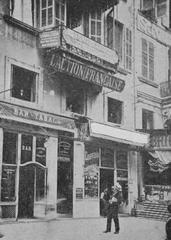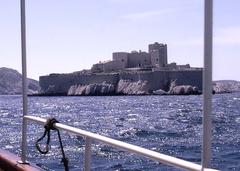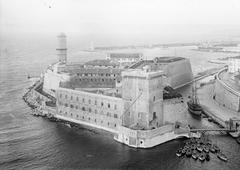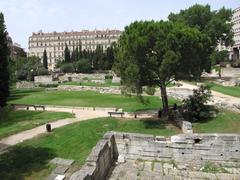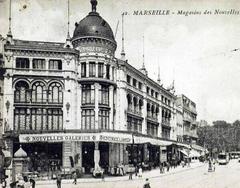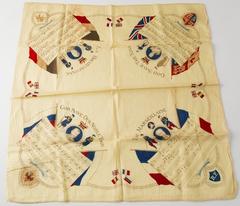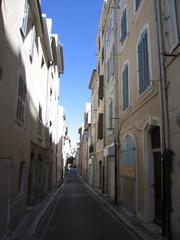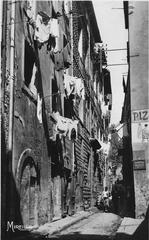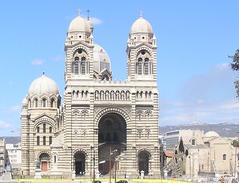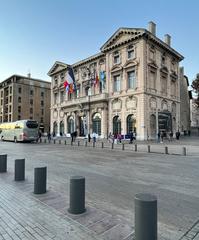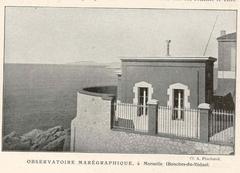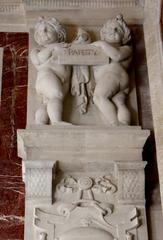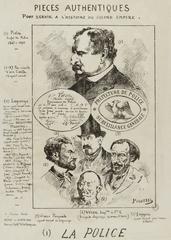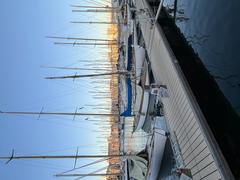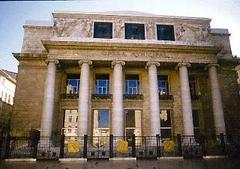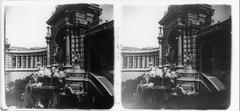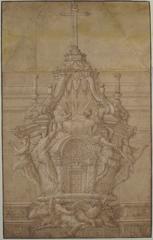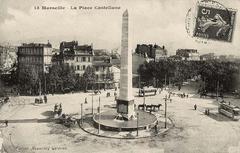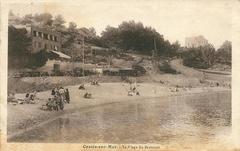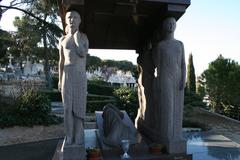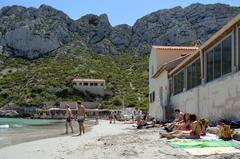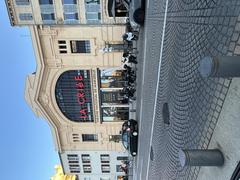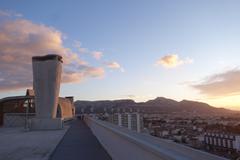
Visiting Église Notre-Dame-des-Accoules in Marseille, France
Date: 04/07/2025
Introduction: Exploring Marseille’s Historic Gem
Église Notre-Dame-des-Accoules is a landmark that encapsulates Marseille’s layered history and enduring spirit. Situated in the heart of the Panier, the city’s oldest district, the church stands atop the remnants of a Roman temple dedicated to Minerva. Over centuries, it has witnessed Marseille’s evolution—from antiquity through the Middle Ages, the turbulence of the French Revolution, and its 19th-century revival. Today, it remains a vibrant place of worship and a cornerstone of local heritage, drawing visitors with its iconic bell tower, unique blend of architectural styles, and deep-rooted community significance.
Whether you are passionate about history, architecture, or simply wish to immerse yourself in Marseille’s cultural life, Notre-Dame-des-Accoules offers a memorable experience. This comprehensive guide presents essential details for planning your visit, including hours, accessibility, nearby attractions, and expert tips to make the most of your journey.
For the latest updates and official information, consult the Marseille Tourism website, France-Voyage, and Marseille Tourisme.
Key Information At a Glance
- Location: 10 Place Daviel, 2nd arrondissement, Marseille (Panier district)
- Admission: Free (donations encouraged)
- Typical Visiting Hours:
- Monday–Saturday: 9:00 AM – 6:00 PM
- Sunday & Public Holidays: 10:00 AM – 1:00 PM; 3:00 PM – 6:00 PM
- Note: Access outside service times can be limited; verify with official sources before visiting.
- Guided Tours: Available on weekends and by appointment (contact local tourism offices)
- Accessibility: Main nave and courtyard are wheelchair accessible; crypts and some historic sections have limited access
- Nearby Attractions: Vieux-Port, Abbaye Saint-Victor, Vieille Charité, Le Panier, La Major Cathedral
Historical Overview: From Antiquity to Modern Day
Notre-Dame-des-Accoules is rooted in Marseille’s early history, constructed atop what was once a Roman temple. The first documented mention of the church dates to 1033, and by 1060, it became affiliated with the influential Abbey of Saint-Victor. The name “Accoules” likely refers to the arches (“acoulas” in Provençal) that characterized its original medieval design (tourisme-marseille.com).
The church underwent several reconstructions, notably in 1205 and the 14th century when it was rebuilt in the southern Gothic style. The French Revolution marked a dramatic chapter, as the church was largely demolished for its association with counter-revolutionaries. Only the distinctive bell tower and rear wall survived this period of destruction.
In the early 19th century, Notre-Dame-des-Accoules was reborn with a neoclassical facade and a crypt (symbolizing the Holy Sepulchre), completed between 1824 and 1826. The result is a unique blend of Gothic and neoclassical elements, reflecting Marseille’s endurance and renewal.
Architectural Highlights
The Bell Tower
A defining feature of the Marseille skyline, the medieval bell tower is a rare example of Provençal Gothic architecture. Built on the base of the ancient Tour Sauveterre, it historically served both religious and civic purposes, including summoning the city council and alerting citizens in emergencies. Its lower square section supports an octagonal upper part, culminating in a slender spire visible throughout the Panier (marseilletourisme.fr).
The Facade and Interior
The neoclassical facade dates to the 19th century and contrasts with the church’s medieval origins. The entrance, accessed through a peaceful courtyard, leads to a centralized interior plan—an intimate worship space focused on the altar. The Chapelle du Calvaire and the crypts are atmospheric highlights, offering a quiet connection to the church’s ancient past.
Surviving Medieval Elements
Despite revolutionary turmoil, elements such as the rear wall with traces of the three original naves and columns inscribed with the date 1205 remain, anchoring the site to its medieval roots (France-Voyage).
Visiting Église Notre-Dame-des-Accoules: Hours, Tickets, and Tips
Visiting Hours
- General Access:
- Monday–Saturday: 9:00 AM – 6:00 PM
- Sunday & Holidays: 10:00 AM – 1:00 PM and 3:00 PM – 6:00 PM
- Service times for public mass: Tuesdays, Thursdays, Saturdays at 6:00 PM; Sundays at 10:30 AM (marseilletourisme.fr)
- Best Time to Visit: Early morning or late afternoon for a peaceful experience and ideal lighting for photography.
Tickets and Admission
- Entry: Free of charge for all visitors. Donations are welcome to support the church’s preservation.
Guided Tours and Special Events
- Guided Tours: Highly recommended for those interested in history and architecture; available on weekends or by special arrangement through the Marseille tourism office.
- Special Events:
- Christmas crèche (nativity scene) displays in the crypt
- Concerts and occasional cultural events
- Pilgrimages and local commemorations
Accessibility
- Wheelchair Access: Courtyard and main nave are accessible; crypts and some areas may have steps or uneven floors.
- Mobility: The Panier district has steep, cobblestone streets—comfortable footwear is essential.
What to See and Do Nearby
- Vieux-Port: The vibrant Old Port area, ideal for markets, dining, and boat tours.
- Abbaye Saint-Victor: Another historic church with medieval origins.
- La Vieille Charité: A cultural center housed in a former charity hospital.
- Le Panier: Wander through Marseille’s oldest neighborhood, known for street art, artisan shops, and local cafés.
- La Major Cathedral: A striking neo-Byzantine cathedral nearby.
Combine your visit with a walking tour for a deeper understanding of Marseille’s historical heart (GPSmyCity).
Visitor Experience and Practical Tips
- Dress Code: Modest attire is recommended when attending services or entering the church.
- Photography: Permitted outside services; always be discreet and respectful.
- Amenities: Cafés, shops, and public restrooms are available in the surrounding area.
- Approach: The church is reached via the Montée des Accoules staircase, adding a sense of discovery.
Frequently Asked Questions (FAQ)
Q: What are the Église Notre-Dame-des-Accoules visiting hours?
A: Typically Monday–Saturday, 9:00 AM–6:00 PM; Sunday & holidays 10:00 AM–1:00 PM and 3:00 PM–6:00 PM. Verify before visiting.
Q: Is there an entry fee?
A: No, entry is free; donations are encouraged.
Q: Are guided tours available?
A: Yes, usually on weekends or by request via the tourism office.
Q: Is the church accessible for wheelchair users?
A: Main spaces are accessible, but some historic areas have limited access.
Q: Can I take photos inside?
A: Yes, outside of services and with discretion.
Q: What other attractions are nearby?
A: La Vieille Charité, Vieux-Port, Le Panier, La Major Cathedral.
Cultural Significance and Community Role
Notre-Dame-des-Accoules is more than a monument; it is a living symbol of Marseille’s resilience and diversity. The church’s history mirrors that of the city—marked by conflict, renewal, and enduring faith. It remains an active parish, hosting religious services, local events, and serving as a hub for the neighborhood’s community life. Preservation efforts ensure that its architectural and cultural legacy endures for future generations (France-Voyage).
Plan Your Visit: Next Steps
- Check current hours and events: Always refer to official sources before your visit.
- Download the Audiala app: For curated walking tours and insider tips.
- Explore nearby sites: Make the most of your day by visiting other Panier and Old Port attractions.
- Stay updated: Follow local tourism boards and heritage organizations for news on special events or exhibitions.
References
Conclusion
A visit to Église Notre-Dame-des-Accoules is more than a step back in time; it’s an immersion in the living history and soul of Marseille. Its unique architecture, stirring past, and central role in community life make it essential for anyone seeking to understand the city’s heritage. Plan your visit, explore the surrounding Panier, and let this iconic church enrich your journey through France’s oldest city.










